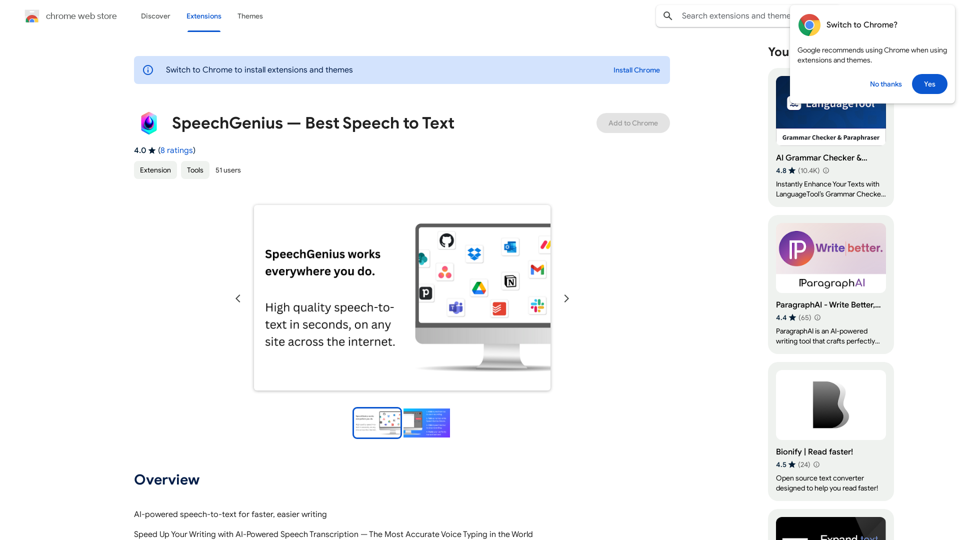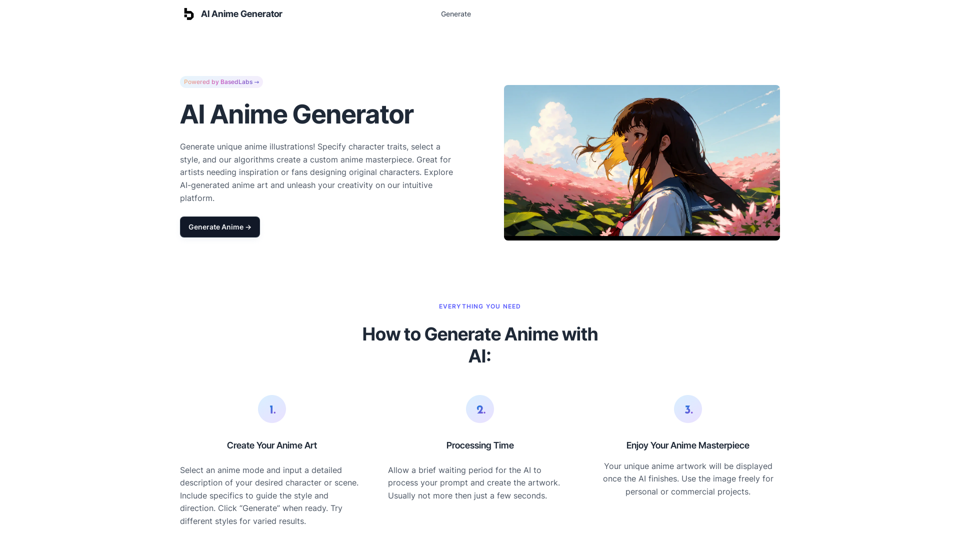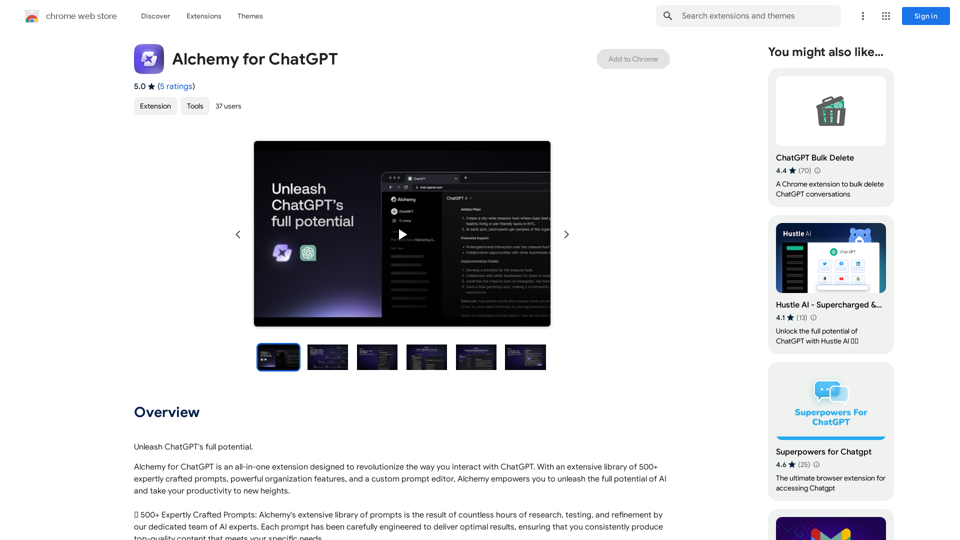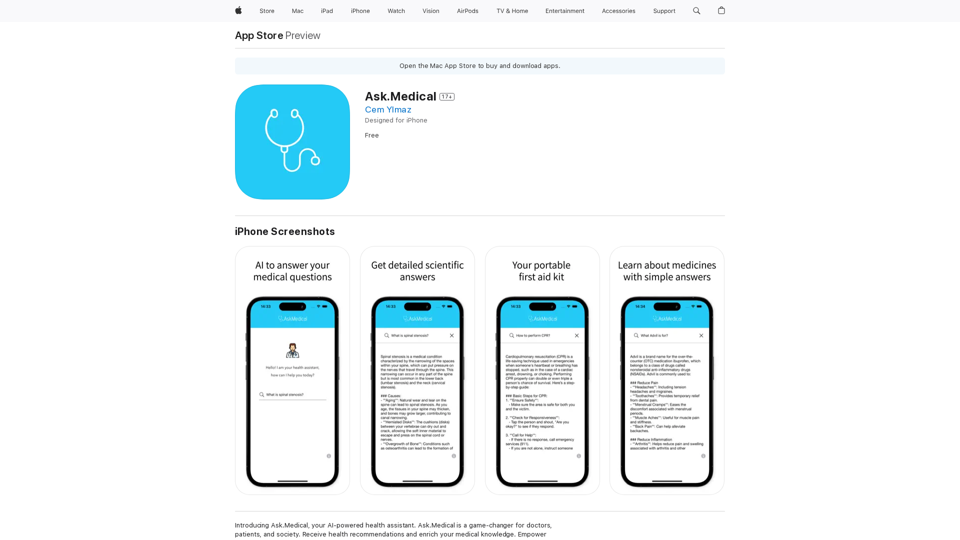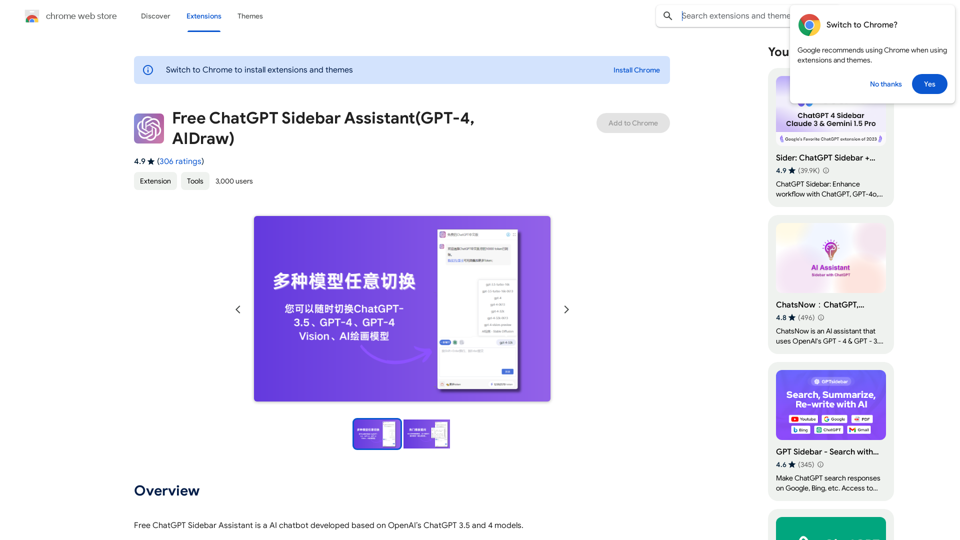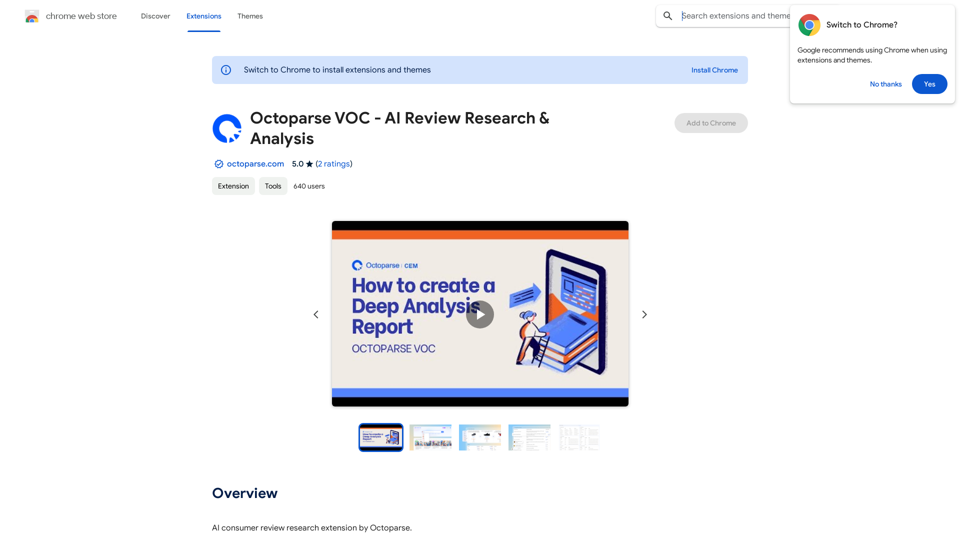LessonShipは、教師が教室の指導教材を作成・管理する方法を革新するために設計された革新的なAI駆動のプラットフォームです。高度な人工知能技術を活用することで、LessonShipは教育者が高品質の授業計画、宿題、クイズ、評価基準を迅速に生成することを可能にします。この効率的なツールは時間を節約するだけでなく、コンテンツが教育基準に沿っていることを保証し、現代の教育者にとって貴重な資産となっています。
!
LessonShipは、私たちの簡単なフォームを使用して、教師がクラスルームの指導教材をすばやく生成できるAIパワーのLMSです。
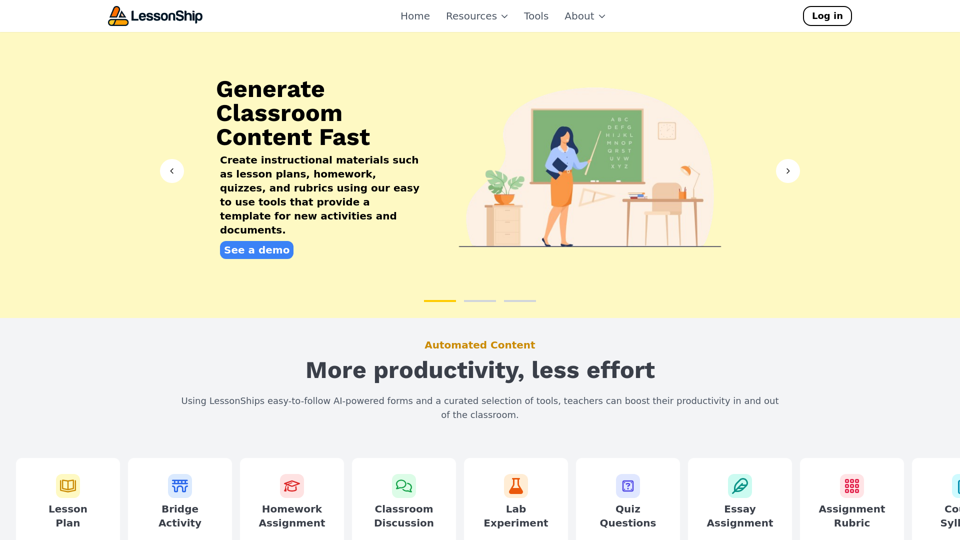
紹介
機能
AI駆動のフォーム生成
LessonShipの中核機能は、インテリジェントなフォーム生成システムを中心に展開されています。教師は、ユーザーフレンドリーなフォームに記入するだけで、幅広い指導教材を簡単に作成できます。この機能により、授業準備に必要な時間と労力が大幅に削減されます。
編集・整理ツール
このプラットフォームは、教師が以下のことを可能にする堅牢な編集・整理機能を提供します:
- 生成されたコンテンツのカスタマイズ
- 教材の管理と分類
- コンテンツの簡単な検索と再利用
この合理化されたアプローチにより、効率性が向上し、リソース管理が改善されます。
基準に沿ったコンテンツ作成
LessonShipは、生成されたすべての教材が特定の教育基準を満たすようにカスタマイズできることを保証します。この機能により以下が保証されます:
- コンテンツがカリキュラム要件に沿っている
- 学習目標が一貫して達成される
- 生徒が標準化された高品質の教育教材を受け取る
学習管理システム(LMS)との統合
ワークフローをさらに合理化するために、LessonShipは以下のような人気のLMSプラットフォームとシームレスに統合されています:
- Google Classroom
- Canvas
- その他の一般的なLMSソリューション
この統合により、より一貫性のある効率的な教育体験が可能になります。
FAQ
LessonShipはどのような種類の指導教材を生成できますか?
LessonShipは以下を含む様々な教室教材を生成できます:
- 授業計画
- 宿題
- クイズ
- 評価基準
- その他の重要な教育リソース
LessonShipはどれくらいユーザーフレンドリーですか?
LessonShipは使いやすさを念頭に設計されています。教師は直感的なフォームに記入するだけで教材を生成できるため、技術的な専門知識が限られている人でもプラットフォームを利用できます。
LessonShipには異なる価格オプションがありますか?
はい、LessonShipは異なるニーズと予算に対応するために様々な価格プランを提供しています。学校や教育者は、利用可能な価格オプションの詳細情報についてLessonShipチームにお問い合わせください。
最新のトラフィック情報
月間訪問数
0
直帰率
0.00%
訪問あたりのページ数
0.00
サイト滞在時間(s)
0.00
グローバルランキング
-
国別ランキング
-
最近の訪問数
トラフィック源
- ソーシャルメディア:0.00%
- 有料リファラル:0.00%
- メール:0.00%
- リファラル:0.00%
- 検索エンジン:0.00%
- ダイレクト:0.00%
関連ウェブサイト
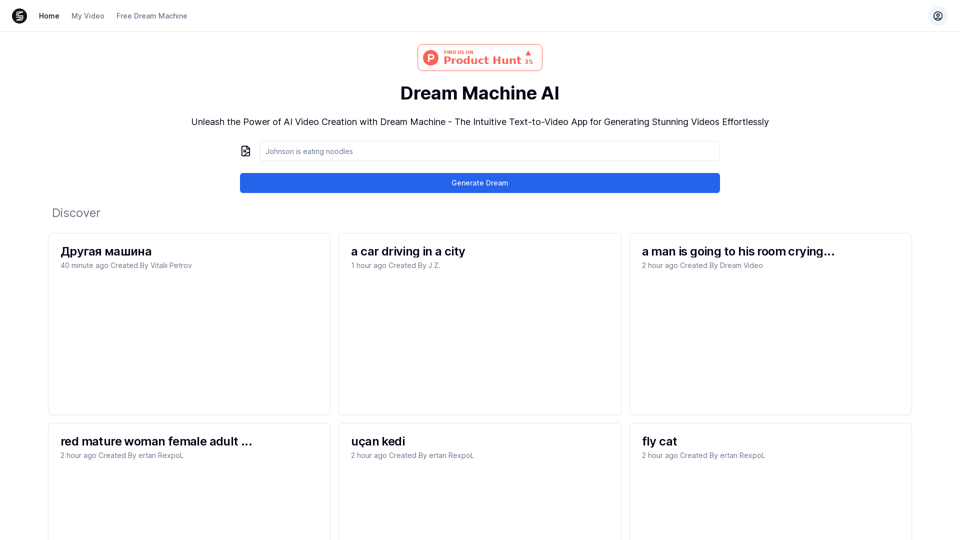
Dream Machine AIã«ã‚ˆã£ã¦ã„ãã¦ããŸã¨ã¦ããŸã¦ããŸã¦ããŸã¦ããŸã¦ããŸã¦ããŸã¦ããŸã¦ããŸã¦ããŸã¦ããŸã¦ããŸã¦ããŸã¦ããŸã¦ããŸã¦ããŸã¦ããŸã¦ããŸã¦ããŸã¦ããŸã¦ããŸã¦ããŸã¦ããŸã¦ããŸã¦ããŸã¦ããŸã¦ããŸã¦ããŸã¦ããŸã¦ããŸã¦ããŸã¦ããŸã¦ããŸã¦ããŸã¦ããŸã¦ããŸã¦ããŸã¦ããŸã¦ããŸã¦ããŸã¦ããŸã¦ããŸã¦ããŸã¦ããŸã¦ããŸã¦ããŸã¦ããŸã¦ããŸã¦ããŸã¦ããŸã¦ããŸã¦ããŸã¦ããŸã¦ããŸã¦ããŸã¦ããŸã¦ããŸã¦ããŸã¦ããŸã¦ããŸã¦ããŸã¦ããŸã¦ããŸã¦ããŸã¦ããŸã¦ããŸã¦ããŸã¦ããŸã¦ããŸã¦ããŸã¦ããŸã¦ããŸã¦ããŸã¦ããŸã¦ããŸã¦ããŸã¦ããŸã¦ããŸã¦ããŸã¦ããŸã¦ããŸã¦ããŸã¦ããŸã¦ããŸã¦ããŸã¦ããŸã¦ããŸã¦ããŸã¦ããŸã¦ããŸã¦ããŸã¦ããŸã¦ããŸã¦ããŸã¦ããŸã¦ããŸã¦ããŸã¦ããŸã¦ããŸã¦ããŸã¦ããŸã¦ããŸã¦ããŸã¦ããŸã¦ããŸã¦ããŸã¦ããŸã¦ããŸã¦ããŸã¦ããŸã¦ããŸã¦ããŸã¦ããŸã¦ããŸã¦ããŸã¦ããŸã¦ããŸã¦ããŸã¦ããŸã¦ããŸã¦ããŸã¦ããŸã¦ããŸã¦ããŸã¦ããŸã¦ããŸã¦ããŸã¦ããŸã¦ããŸã¦ããŸã¦ããŸã¦ããŸã¦ããŸã¦ããŸã¦ããŸã¦ããŸã¦ããŸã¦ããŸã¦ããŸã¦ããŸã¦ããŸã¦ããŸã¦ããŸã¦ããŸã¦ããŸã¦ããŸã¦ããŸã¦ããŸã¦ããŸã¦ããŸã¦ããŸã¦ããŸã¦ããŸã¦ããŸã¦ããŸã¦ããŸã¦ããŸã¦ããŸã¦ããŸã¦ããŸã¦ããŸã¦ããŸã¦ããŸã¦ããŸã¦ããŸã¦ããŸã¦ããŸã¦ããŸã¦ããŸã¦ããŸã¦ããŸã¦ããŸã¦ããŸã¦ããŸã¦ããŸã¦ããŸã¦ããŸã¦ããŸã¦ããŸã¦ããŸã¦ããŸã¦ããŸã¦ããŸã¦ããŸã¦ããŸã¦ããŸã¦ããŸã¦ããŸã¦ããŸã¦ããŸã¦ããŸã¦ããŸã¦ããŸã¦ããŸã¦ããŸã¦ããŸã¦ããŸã¦ããŸã¦ããŸã¦ããŸã¦ããŸã¦ããŸã¦ããŸã¦ããŸã¦ããŸã¦ããŸã¦ããŸã¦ããŸã¦ããŸã¦ããŸã¦ããŸã¦ããŸã¦ããŸã¦ããŸã¦ããŸã¦ããŸã¦ããŸã¦ããŸã¦ããŸã¦ããŸã¦ããŸã¦ããŸã¦ããŸã¦ããŸã¦ããŸã¦ããŸã¦ããŸã¦ããŸã¦ããŸã¦ããŸã¦ããŸã¦ããŸã¦ããŸã¦ããŸã¦ããŸã¦ããŸã¦ããŸã¦ããŸã¦ããŸã¦ããŸã¦ããŸã¦ããŸã¦ããŸã¦ããŸã¦ããŸã¦ããŸã¦ããŸã¦ããŸã¦ããŸã¦ããŸã¦ããŸã¦ããŸã¦ããŸã¦ããŸã¦ããŸã¦ããŸã¦ããŸã¦ããŸã¦ããŸã¦ããŸã¦ããŸã¦ããŸã¦ããŸã¦ããŸã¦ããŸã¦ããŸã¦ããŸã¦ããŸã¦ããŸã¦ããŸã¦ããŸã¦ããŸã¦ããŸã¦ããŸã¦ããŸã¦ããŸã¦ããŸã¦ããŸã¦ããŸã¦ããŸã¦ããŸã¦ããŸã¦ããŸã¦ããŸã¦ããŸã¦ããŸã¦ããŸã¦ããŸã¦ããŸã¦ããŸã¦ããŸã¦ããŸã¦ããŸã¦ããŸã¦ããŸã¦ããŸã¦ããŸã¦ããŸã¦ããŸã¦ããŸã¦ããŸã¦ããŸã¦ããŸã¦ããŸã¦ããŸã¦ããŸã¦ããŸã¦ããŸã¦ããŸã¦ããŸã¦ããŸã¦ããŸã¦ããŸã¦ããŸã¦ããŸã¦ããŸã¦ããŸã¦ããŸã¦ããŸã¦ããŸã¦ããŸã¦ããŸã¦ããŸã¦ããŸã¦ããŸã¦ããŸã¦ããŸã¦ããŸã¦ããŸã¦ããŸã¦ããŸã¦ããŸã¦ããŸã¦ããŸã¦ããŸã¦ããŸã¦ããŸã¦ããŸã¦ããŸã¦ããŸã¦ããŸã¦ããŸã¦ããŸã¦ããŸã¦ããŸã¦ããŸã¦ããŸã¦ããŸã¦ããŸã¦ããŸã¦ããŸã¦ããŸã¦ããŸã¦ããŸã¦ããŸã¦ããŸã¦ããŸã¦ããŸã¦ããŸã¦ããŸã¦ããŸã¦ããŸã¦ããŸã¦ããŸã¦ããŸã¦ããŸã¦ããŸã¦ããŸã¦ããŸã¦ããŸã¦ããŸã¦ããŸã¦ããŸã¦ããŸã¦ããŸã¦ããŸã¦ããŸã¦ããŸã¦ããŸã¦ããŸã¦ããŸã¦ããŸã¦ããŸã¦ããŸã¦ããŸã¦ããŸã¦ããŸã¦ããŸã¦ããŸã¦ããŸã¦ããŸã¦ããŸã¦ããŸã¦ããŸã¦ããŸã¦ããŸã¦ããŸã¦ããŸã¦ããŸã¦ããŸã¦ããŸã¦ããŸã¦ããŸã¦ããŸã¦ããŸã¦ããŸã¦ããŸã¦ããŸã¦ããŸã¦ããŸã¦ããŸã¦ããŸã¦ããŸã¦ããŸã¦ããŸã¦ããŸã¦ããŸã¦ããŸã¦ããŸã¦ããŸã¦ããŸã¦ããŸã¦ããŸã¦ããŸã¦ããŸã¦ããŸã¦ããŸã¦ããŸã¦ããŸã¦ããŸã¦ããŸã¦ããŸã¦ããŸã¦ããŸã¦ããŸã¦ããŸã¦ããŸã¦ããŸã¦ããŸã¦ããŸã¦ããŸã¦ããŸã¦ããŸã¦ããŸã¦ããŸã¦ããŸã¦ããŸã¦ããŸã¦ããŸã¦ããŸã¦ããŸã¦ããŸã¦ããŸã¦ããŸã¦ããŸã¦ããŸã¦ããŸã¦ããŸã¦ããŸã¦ããŸã¦ããŸã¦ããŸã¦ããŸã¦ããŸã¦ããŸã¦ããŸã¦ããŸã¦ããŸã¦ããŸã¦ããŸã¦ããŸã¦ããŸã¦ããŸã¦ããŸã¦ããŸã¦ããŸã¦ããŸã¦ããŸã¦ããŸã¦ããŸã¦ããŸã¦ããŸã¦ããŸã¦ããŸã¦ããŸã¦ããŸã¦ããŸã¦ããŸã¦ããŸã¦ããŸã¦ããŸã¦ããŸã¦ããŸã¦ããŸã¦ããŸã¦ããŸã¦ããŸã¦ããŸã¦ããŸã¦ããŸã¦ããŸã¦ããŸã¦ããŸã¦ããŸã¦ããŸã¦ããŸã¦ããŸã¦ããŸã¦ããŸã¦ããŸã¦ããŸã¦ããŸã¦ããŸã¦ããŸã¦ããŸã¦ããŸã¦ããŸã¦ããŸã¦ããŸã¦ããŸã¦ããŸã¦ããŸã¦ããŸã¦ããŸã¦ããŸã¦ããŸã¦ããŸã¦ããŸã¦ããŸã¦ããŸã¦ããŸã¦ããŸã¦ããŸã¦ããŸã¦ããŸã¦ããŸã¦ããŸã¦ããŸã¦ããŸã¦ããŸã¦ããŸã¦ããŸã¦ããŸã¦ããŸã¦ããŸã¦ããŸã¦ããŸã¦ããŸã¦ããŸã¦ããŸã¦ããŸã¦ããŸã¦ããŸã¦ããŸã¦ããŸã¦ããŸã¦ããŸã¦ããŸã¦ããŸã¦ããŸã¦ããŸã¦ããŸã¦ããŸã¦ããŸã¦ããŸã¦ããŸã¦ããŸã¦ããŸã¦ããŸã¦ããŸã¦ããŸã¦ããŸã¦ããŸã¦ããŸã¦ããŸã¦ããŸã¦ããŸã¦ããŸã¦ããŸã¦ããŸã¦ããŸã¦ããŸã¦ããŸã¦ããŸã¦ããŸã¦ããŸã¦ããŸã¦ããŸã¦ããŸã¦ããŸã¦ããŸã¦ããŸã¦ããŸã¦ããŸã¦ããŸã¦ããŸã¦ããŸã¦ããŸã¦ããŸã¦ããŸã¦ããŸã¦ããŸã¦ããŸã¦ããŸã¦ããŸã¦ããŸã¦ããŸã¦ããŸã¦ããŸã¦ããŸã¦ããŸã¦ããŸã¦ããŸã¦ããŸã¦ããŸã¦ããŸã¦ããŸã¦ããŸã¦ããŸã¦ããŸã¦ããŸã¦ããŸã¦ããŸã¦ããŸã¦ããŸã¦ããŸã¦ããŸã¦ããŸã¦ããŸã¦ããŸã¦ããŸã¦ããŸã¦ããŸã¦ããŸã¦ããŸã¦ããŸã¦ããŸã¦ããŸã¦ããŸã¦ããŸã¦ããŸã¦ããŸã¦ããŸã¦ããŸã¦ããŸã¦ããŸã¦ããŸã¦ããŸã¦ããŸã¦ããŸã¦ããŸã¦ããŸã¦ããŸã¦ããŸã¦ããŸã¦ããŸã¦ããŸã¦ããŸã¦ããŸã¦ããŸã¦ããŸã¦ããŸã¦ããŸã¦ããŸã¦ããŸã¦ããŸã¦ããŸã¦ããŸã¦ããŸã¦ããŸã¦ããŸã¦ããŸã¦ããŸã¦ããŸã¦ããŸã¦ããŸã¦ããŸã¦ããŸã¦ããŸã¦ããŸã¦ããŸã¦ããŸã¦ããŸã¦ããŸã¦ããŸã¦ããŸã¦ããŸã¦ããŸã¦ããŸã¦ããŸã¦ããŸã¦ããŸã¦ããŸã¦ããŸã¦ããŸã¦ããŸã¦ããŸã¦ããŸã¦ããŸã¦ããŸã¦ããŸã¦ããŸã¦ããŸã¦ããŸã¦ããŸã¦ããŸã¦ããŸã¦ããŸã¦ããŸã¦ããŸã¦ããŸã¦ããŸã¦ããŸã¦ããŸã¦ããŸã¦ããŸã¦ããŸã¦ããŸã¦ããŸã¦ããŸã¦ããŸã¦ããŸã¦ããŸã¦ããŸã¦ããŸã¦ããŸã¦ããŸã¦ããŸã¦ããŸã¦ããŸã¦ããŸã¦ããŸã¦ããŸã¦ããŸã¦ããŸã¦ããŸã¦ããŸã¦ããŸã¦ããŸã¦ããŸã¦ããŸã¦ããŸã¦ããŸã¦ããŸã¦ããŸã¦ããŸã¦ããŸã¦ããŸã¦ããŸã¦ããŸã¦ããŸã¦ããŸã¦ããŸã¦ããŸã¦ããŸã¦ããŸã¦ããŸã¦ããŸã¦ããŸã¦ããŸã¦ããŸã¦ããŸã¦ããŸã¦ããŸã¦ããŸã¦ããŸã¦ããŸã¦ããŸã¦ããŸã¦ããŸã¦ããŸã¦ããŸã¦ããŸã¦ããŸã¦ããŸã¦ããŸã¦ããŸã¦ããŸã¦ããŸã¦ããŸã¦ããŸã¦ããŸã¦ããŸã¦ããŸã¦ããŸã¦ããŸã¦ããŸã¦ããŸã¦ããŸã¦ããŸã¦ããŸã¦ããŸã¦ããŸã¦ããŸã¦ããŸã¦ããŸã¦ããŸã¦ããŸã¦ããŸã¦ããŸã¦ããŸã¦ããŸã¦ããŸã¦ããŸã¦ããŸã¦ããŸã¦ããŸã¦ããŸã¦ããŸã¦ããŸã¦ããŸã¦ããŸã¦ããŸã¦ããŸã¦ããŸã¦ããŸã¦ããŸã¦ããŸã¦ããŸã¦ããŸã¦ããŸã¦ããŸã¦ããŸã¦ããŸã¦ããŸã¦ããŸã¦ããŸã¦ããŸã¦ããŸã¦ããŸã¦ããŸã¦ããŸã¦ããŸã¦ããŸã¦ããŸã¦ããŸã¦ããŸã¦ããŸã¦ããŸã¦ããŸã¦ããŸã¦ããŸã¦ããŸã¦ããŸã¦ããŸã¦ããŸã¦ããŸã¦ããŸã¦ããŸã¦ããŸã¦ããŸã¦ããŸã¦ããŸã¦ããŸã¦ããŸã¦ããŸã¦ããŸã¦ããŸã¦ããŸã¦ããŸã¦ããŸã¦ããŸã¦ããŸã¦ããŸã¦ããŸã¦ããŸã¦ããŸã¦ããŸã¦ããŸã¦ããŸã¦ããŸã¦ããŸã¦ããŸã¦ããŸã¦ããŸã¦ããŸã¦ããŸã¦ããŸã¦ããŸã¦ããŸã¦ããŸã¦ããŸã¦ããŸã¦ããŸã¦ããŸã¦ããŸã¦ããŸã¦ããŸã¦ããŸã¦ããŸã¦ããŸã¦ããŸã¦ããŸã¦ããŸã¦ããŸã¦ããŸã¦ããŸã¦ããŸã¦ã
7.28 K
